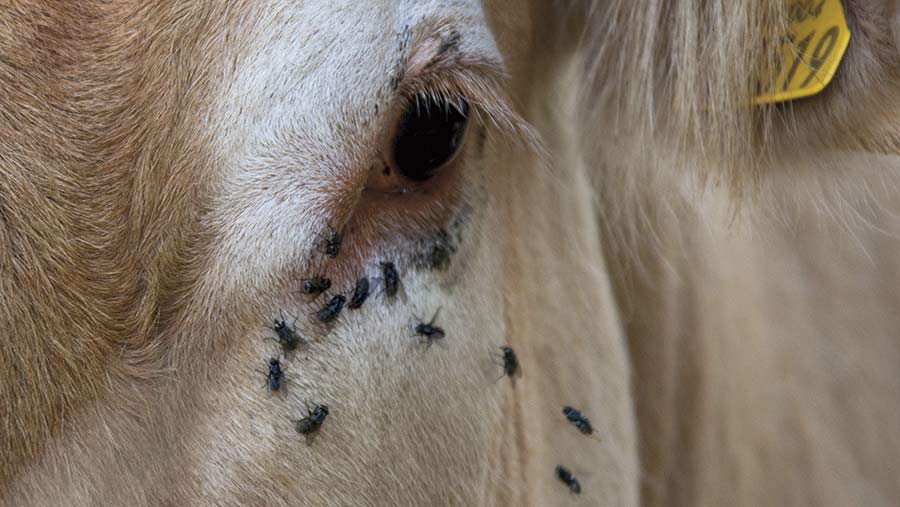Vet Viewpoint: Flies, BVD and oversized lambs
 © Tim Scrivener
© Tim Scrivener Turnout brings warnings and advice from vets to farmers with stock at grass in the late spring.
Emyr Rowlands of Willows Farm Animal Veterinary Practice warns about problems caused by flies and bovine viral diarrhoea (BVD).
Steve Glanvill of Hook Norton Veterinary Group discusses oversized lambs and calves at the tail-end of lambing and calving, and Charlie Neale from Shepton Veterinary Group discussion dry cow nutrition during the grazing season.
There’s also a timely reminder to keep stock fencing secure.
Cheshire

Emyr Rowlands
Emyr Rowlands, Willows Farm Animal Veterinary Practice, Northwich, Cheshire
Summer is fast approaching and flies are already an issue on some farms.
Not only are they a nuisance to both stock and people, but they also spread diseases such as summer mastitis, infectious keratoconjunctivitis (New Forest pink eye) and even BVD.
See also: Vet Viewpoint: Nematodirus and the importance of fertility checks
Control of flies is often undertaken with permethrin-based pour-on products, but consideration should also be given to the control of the environment in which the flies breed.
Efficient muck management, together with good drainage and ventilation, will all help reduce the fly population.
Young calves are particularly vulnerable, as their pens or hutches are a good breeding ground for flies. If they are irritated by flies they are less likely to eat. If they don’t eat, they won’t grow, so next time you treat your herd for flies, please don’t forget about your calves.
Oxford

Steve Glanvill
Steve Glanvill, Hook Norton Veterinary Group LLP, Banbury
As we get to the tail end of calving and lambing, we invariably see problems with oversized calves and lambs.
Some sheep breeds in particular have large heads, and single lambs can be large and difficult to lamb.
We find a head snare vital for these lambs and large calves, as it enables you to pull on the legs and at the same time guide the head through the pelvis without having to use your hand.
The snare should be placed behind the ears and close at the opening of the mouth. If the head will not come into the pelvis with a snare, it is time to call for a vet to help, as a caesarean may be required to deliver a live lamb or calf.
Oversize problems can be avoided by careful control of feeding during later pregnancy and choosing sires with an easy calving or lambing history, especially in heifers and ewe lambs.
Ayrshire

Edward Hewitt
Edward Hewitt, Armour Veterinary Group, Mauchline
BVD continues to be at the forefront of farmers’ minds as we complete our spring rush of testing prior to turnout.
We have seen a number of herds that had a “negative” status change to “not negative” as a result of one or two antibody-positive animals being found at the screening.
After reviewing on-farm biosecurity, animal movements and disease history, these positive animals have often been put down to over-the-fence contact with neighbouring stock.
It serves as a timely reminder that farm boundaries need to be secure and effective measures put in place to prevent nose-to-nose contact with neighbouring livestock – a 3m double fence is appropriate, with breeding females grazed away from farm boundaries if at all possible.
Somerset

Charlie Neale
Charlie Neale, Shepton Veterinary Group, Shepton Mallet
Dry cow nutrition during the grazing season is easy to overlook, particularly when controlling hypocalcaemia (milk fever) – where we see an increase in cases at grass.
The main reason for this is that magnesium intake from a grass-based diet will only be about half the level required to significantly reduce milk fever risk.
In both its clinical and subclinical forms, milk fever is a costly disease, with current estimates from £50-£164 depending on severity.
Blood samples from freshly calved cows can be analysed to assess whether milk fever is being controlled adequately, and if it is not, simple steps such as magnesium supplementation or diet alteration can often be taken to ensure that the risk of the disease is minimised.
